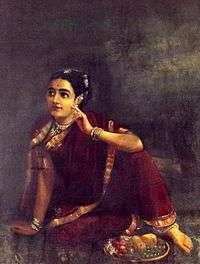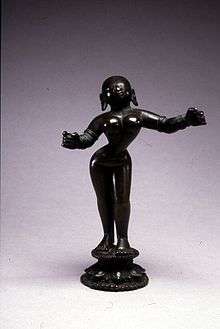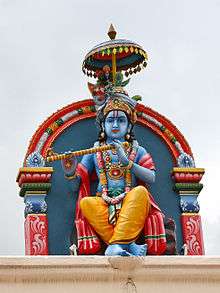Radha
Radha (Sanskrit: राधा, IAST: Rādhā), also called Radhika, Madhavi, Keshavi, Raseshwari and Radharani is a goddess in Hinduism, especially in the Gaudiya Vaishnavism tradition and is worshipped as the goddess of love, tenderness, compassion and devotion. She is the eternal consort of Lord Krishna and resides with him in their eternal abode Goloka dham. She is the internal potency or Hladini Shakti (Blissful energy) of Krishna. According to scriptures, she was the chief of the brij gopis (milkmaids) who are known for their supreme devotion towards Krishna. She is the personification of para bhakti (complete devotion) unto Shri Krishna (Bhakti Devi) and is revered as the epitome of selfless love and service towards Krishna. She is also considered by some as the feminine form of Lord Krishna himself.[6][7] Every year Radharani's birthday is celebrated as Radhashtami.
| Radha | |
|---|---|
Goddess of Love, Beauty and Devotion | |
 Painting of Radha in Rajsthani style | |
| Affiliation | Krishna, Radha Krishna, Queen of Barsana and Vrindavan, Queen of Goloka, Mahalakshmi, Hladini Shakti |
| Abode | Goloka, Vaikunth, Barsana, Vrindavan, Braj Dham. |
| Symbol | Golden Lotus |
| Texts | Brahma Vaivarta Purana, Devi-Bhagavata Purana, Padma Purana,[1] Bhagavata Purana,[2] Brahmanda Purana,[3] Narada Panchratra,[4] Chaitanya Charitamrita, Shree Krishna Karnamrutam, Jagannath Vallabha Natakam, Tartam Sagar, Gita Govinda matsya purana, and many more |
| Festivals | Radhastami, Holi, Gopashtami, Kartik Purnima |
| Personal information | |
| Born | Barsana (Uttar Pradesh, India) |
| Parents |
|
| Consort | Krishna |
She is also considered by some as a metaphor for the human spirit (aatma), her love and longing for Lord Krishna is theologically viewed as symbolic of the human quest for spiritual growth and union with the divine.[8] She has inspired numerous literary works,[9] and her Rasa lila dance with Krishna has inspired many types of performance arts.[10]
She is also called Vrindavaneshwari (Queen of the Sri Vrindavan Dham) who appeared as the queen of milkmaids and queen of Vrindavan-Barsana. She is the supreme goddess in Vaishnavism. Rasik sants have mentioned her as a descension of the Supreme Goddess, source of the Infinite Lakshmi, the original form of Yogamaya and Hladini Shakti (Power of Divine Love) which is the main power of the Godhead Shri Krishna.
Radha is worshipped in India, particularly by Gaudiya Vaishnavas, Vaishnavas in West Bengal, Bangladesh Manipur, and Odisha. Elsewhere, she is revered in the Nimbarka Sampradaya and movements linked to Shri Chaitanya Mahaprabhu.[9][11]
Etymology
The Sanskrit term Rādhā (Sanskrit: राधा) means "prosperity, success".[12][13] It is a common word and name found in various contexts in the ancient and medieval texts of India.
Radha is the name of the gopi who is the beloved of Krishna. Both Radha and Krishna are the main characters of the Gita Govinda by Jayadeva Gosvami.[12]
Hit Harivansh's and Swami Haridas' books consider Radha the main deity. Here, Radha is not an avatar of Laxmi but a form of Bhagavan Shri Krishna Himself. In the Devi Bhagavat and Brahma Vaivarta Purana, Radha is given as the source of infinite Laxmis, Gopis, and the mother of infinite souls.
The Narada-pancaratra states, "Radha is Gokulesvari, the full embodiment of spontaneous love and the personification of mahabhava [the highest spiritual state]. Bhagavan Sri Krishna, who is the supreme Isvara of all existence and the God among gods, is attained by Her mercy. Sri Radha is Krsna’s internal potency, and She performs worship of Her most beloved Sri Krsna with the entire wealth of Her devotion and service."
In Sammohana-tantra, Durga Devi says, "The name Durga, by which I am known, is Her name. The qualities for which I am famous are Her qualities. The majesty with which I am resplendent is Her majesty. That Maha-Laksmi, Sri Radha, is nondifferent from Sri Krsna. She is His dearmost sweetheart and the crest-jewel of His beloveds."
In Caitanya Charitamrta (Adi-Lila 4.56), Krishnadas Kaviraj Goswami says, "Radha Krishna Ek Atma, Dui Dui Dehadari, Anyaoone Vilase Rasasvadana Kori". This means that both Radha and Krishna are one soul who take the form of two individual bodies so that they can cherish different mood of love (rasa).[14]
Jagadguru Shri Kripalu Ji Maharaj elaborately described the virtue of Radha and has given a brief description of Shri Radha in his lectures and Kirtans. He has said, "She is the Supreme Goddess and is worshipped by everyone including Godhead Shri Krishna himself and that's why she is called Radha, which means "one who is the form of worship."
The term is related to Rādha (Sanskrit: राध), which means "kindness, any gift but particularly the gift of affection, success, wealth".[12] The word appears in the Vedic literature as well as the Epics, but is elusive.[7]
Rādhikā refers to an endearing form of gopi Radha.[12]
Description

Radha is an important goddess in the Vaishnavism traditions of Hinduism. Her traits, manifestations, descriptions, and roles vary by region. Since the earliest times, she has been associated with the cowherd Krishna, who is the speaker of the Bhagavad Gita.[6] In the early Indian literature, mentions of her are elusive. The traditions that venerate her explain this is because she is the secret treasure hidden within the Upanishads, Puranas, and Tantra. During the Bhakti movement era she became more well known as her extraordinary love for Krishna was highlighted.[15]
According to Jaya Chemburkar, there are at least two significant and different aspects of Radha in the literature associated with her, such as Sriradhika namasahasram. One aspect is she is a milkmaid (gopi), another as a female deity similar to those found in the Hindu goddess traditions.[16] She also appears in Hindu arts as ardhanari with Krishna, that is an iconography where half of the image is Radha and the other half is Krishna. This is found in sculpture such as those discovered in Maharashtra, and in texts such as Shiva Purana and Brahmavaivarta Purana.[17] In these texts, this ardhanari is sometimes referred to as Ardharadhavenudhara murti, and it symbolizes the complete union and inseparability of Radha and Krishna.[17]
Birthplace of Radha is actually Raval which is near Gokul but is often said to be Barsana where she lived after her marriage. It is in Barsana that the Lathmar Holi is practised depicting the episode of Krishna going to Barsana and then running away escaping the beating from the womenfolk of Barsana. Radha asked Krishna why he can't marry her, the reply came “Marriage is a union of two souls. You and I are one soul, how can I marry myself?”[18] Several Hindu texts allude to these circumstances.[8]

According to David Kinsley, a professor of Religious Studies known for his studies on Hindu goddesses, the Radha-Krishna love story is a metaphor for divine-human relationship, where Radha is the human devotee or soul who is frustrated with the past, obligations to social expectations and the ideas she inherited, who then longs for real meaning, the true love, the divine (Krishna). This metaphoric Radha (soul) finds new liberation in learning more about Krishna, bonding in devotion and with passion.[8][19]
According to Brahma Vaivarta Purana and Garg Sanhita, Radha and Krishna were married in a forest called Bhandirvan near Vrindavan in the presence of Lord Brahma.
Verse in Srimad Bhagavatam, which is commonly attributed to Radha:
Certainly this particular gopī has perfectly worshiped the all-powerful Personality of Godhead, Govinda, since He was so pleased with Her that He abandoned the rest of us and brought Her to a secluded place
— Srimad Bhagavatam, Canto 10, Chapter 30, Verse 28[20]
Radha and Sita
The Radha-Krishna and Sita-Rama pairs represent two different personality sets, two perspectives on dharma and lifestyles, both cherished in the way of life called Hinduism.[21] Sita is traditionally wedded: the dedicated and virtuous wife of Rama, an introspective temperate paragon of a serious, virtuous man.[22][23][24] Radha is a power potency of Krishna, who is a playful adventurer.[22][21]
Radha and Sita offer two templates within the Hindu tradition.[21] If "Sita is a queen, aware of her social responsibilities", states Pauwels, then "Radha is exclusively focused on her romantic relationship with her lover", giving two contrasting role models from two ends of the moral universe. Yet they share common elements as well. Both face life challenges and are committed to their true love. They are both influential, adored and beloved goddesses in the Hindu culture.
Influence

In some devotional (bhakti) traditions of Vaishnavism that focus on Krishna, Radha represents "the feeling of love towards Krishna".[9] For some of the adherents of these traditions, her importance approaches or even exceeds that of Krishna. Radha is worshipped along with Krishna in Bengal, Assam and Odisha by Vaishnava Hindus. Elsewhere, such as with Visnusvamins, she is a revered deity.[25] She is considered to be Krishna's original shakti, the supreme goddess in both the Nimbarka Sampradaya and following the advent of Chaitanya Mahaprabhu also within the Gaudiya Vaishnava tradition.[9][11]
Radha Chalisa mentions that Krishna accompanies one who chants "Radha" with pure heart. Other gopis are usually considered to be self-willing maidservants (Sevika) of Radha. Radharani's superiority is seen in Krishna's flute, which repeats the name Radha. Between Radha and Rukmini, Radha is superior.
Radha's connection to Krishna is of two types: svakiya-rasa (married relationship) and parakiya-rasa (a relationship signified with eternal mental "love"). The Gaudiya tradition focuses upon parakiya-rasa as the highest form of love, wherein Radha and Krishna share thoughts even through separation. The love the gopis feel for Krishna is also described in this esoteric manner as the highest platform of spontaneous love of God, and not of a sexual nature.
Temples

Radha and Krishna are the focus of temples in the Chaitanya Mahaprabhu, Vallabhacharya, Chandidas and other traditions of Vaishnavism.[11] She is typically shown standing immediately next to Krishna.[11] Some important Radha temples are:
- Barsana and Vrindavan in Mathura District, Northern India contain a large number of temples dedicated to both Radha and Krishna, including the Radhavallabh Temple.[28] Sri Sri Radha Parthasarathi Mandir in Delhi is also the Radha krishna Temple.[29][30]
- The Shree Raseshwari Radha Rani Temple at Radha Madhav Dham in Austin, Texas, USA, established by Jagadguru Shree Kripaluji Maharaj, is one of the largest Hindu Temple complexes in the Western Hemisphere,[31] and the largest in North America.[32][33][34]
See also
- Vrindavan
- Krishna Janmashtami
- Vrindavan Chandrodaya Mandir – the tallest Radha-Krishna temple under construction
References
- Viharamya Naya Nitya Masya Prema Vasi Krutha Imanthu Mathpriyam Vidhi Radhikam Paradevatham Captivated by Her Love I always roam with Her. Know Her as the Supreme Goddess Radha - the embodiment of Supreme Love.
- Sri Shukadeva Goswami expresses- anayaradhyate - There is one Gopi whose service Krishna accepts with highest relish, indicating Srimati Radharani.
- Radha krishnatmika nityam krishno radhatmika dhruvam | The soul of Radha is Krishna and the soul of Krishna is Radha. This is a certain truth
- Yah Krishna saapi Radha ya Radha Krishna eva saha | That transcendental form who is Krishna is certainly Radha. That who is Radha is certainly Krishna. Both are one and the same.
- Jackie Menzies (2006). Goddess: divine energy. Art Gallery of New South Wales. p. 54.
- John Stratton Hawley; Donna Marie Wulff (1982). The Divine Consort: Rādhā and the Goddesses of India. Motilal Banarsidass. pp. 1–12. ISBN 978-0-89581-102-8.
- Miller, Barbara Stoler (1975). "Rādhā: Consort of Kṛṣṇa's Vernal Passion". Journal of the American Oriental Society. American Oriental Society. 95 (4): 655–671. doi:10.2307/601022.
- David Kinsley (1988). Hindu Goddesses: Visions of the Divine Feminine in the Hindu Religious Tradition. University of California Press. pp. 81–86, 89–90. ISBN 978-0-520-90883-3.
- John Stratton Hawley; Donna Marie Wulff (1982). The Divine Consort: Rādhā and the Goddesses of India. Motilal Banarsidass. pp. xiii–xviii. ISBN 978-0-89581-102-8.
- Guy L. Beck (2006). Alternative Krishnas: Regional and Vernacular Variations on a Hindu Deity. State University of New York Press. pp. 46–47. ISBN 978-0-7914-6416-8.
- Roshen Dalal (2010). Hinduism: An Alphabetical Guide. Penguin Books. pp. 321–322. ISBN 978-0-14-341421-6.
- Monier Monier-Williams, Rādhā, Sanskrit-English Dictionary with Etymology, Oxford University Press, page 876
- Sukumar Sen (1943), "Etymology of the name Radha-Krishana," Indian Linguistics, Vol. 8, pp. 434–435
- Krishnadas Kaviraj Goswami, Rādhā, Caitanya Caritamrta Adi-Lila 4.56
- Heidi R. M. Pauwels (1996), The Great Goddess and Fulfilment in Love: Rādhā Seen Through a Sixteenth-Century Lens, Bulletin of the School of Oriental and African Studies, Cambridge University Press, Vol. 59, No. 1 (1996), pp. 29–43
- Jaya Chemburkar (1976), ŚRĪRĀDHIKĀNĀMASAHASRAM, Annals of the Bhandarkar Oriental Research Institute, Vol. 57, No. 1/4 (1976), pp. 107–116
- Shrikant Pradhan (2008), A UNIQUE IMAGE OF "ARDHARADHAVENUDHARAMURTI: OR "ARDHANARI KRISHNA", Bulletin of the Deccan College Research Institute, Vol. 68/69 (2008–2009), pp. 207–213
- Heidi R.M. Pauwels (2008). The Goddess as Role Model: Sita and Radha in Scripture and on Screen. Oxford University Press. pp. 13–14. ISBN 978-0-19-970857-4.
- Roshen Dalal (2010). Hinduism: An Alphabetical Guide. Penguin Books. p. 147. ISBN 978-0-14-341421-6.
- https://vedabase.io/en/ https://vedabase.io/en/library/sb/10/30/28/. Retrieved 24 February 2020. Missing or empty
|title=(help); External link in|website=(help) - Heidi R.M. Pauwels (2008). The Goddess as Role Model: Sita and Radha in Scripture and on Screen. Oxford University Press. pp. 12–15, 497–517. ISBN 978-0-19-970857-4.
- Vālmīki; Robert P Goldman (Translator) (1990). The Ramayana of Valmiki: Balakanda. Princeton University Press. p. 3. ISBN 9781400884551.
- Dimock Jr, E.C. (1963). "Doctrine and Practice among the Vaisnavas of Bengal". History of Religions. 3 (1): 106–127. doi:10.1086/462474. JSTOR 1062079.
- Marijke J. Klokke (2000). Narrative Sculpture and Literary Traditions in South and Southeast Asia. BRILL. pp. 51–57. ISBN 90-04-11865-9.
- Asoke Kumar Majumdar (1955), A Note on the Development of Radha Cult, Annals of the Bhandarkar Oriental Research Institute, Vol. 36, No. 3/4 (July – October 1955), pp. 231–257
- Singh, K.B. (2004). "Manipur Vaishnavism: A Sociological Interpretat1on". Sociology of Religion in India. ISBN 978-0-7619-9781-8. Retrieved 3 May 2008.
- Kinsley, D. (2010). "Without Krsna There Is No Song". History of Religions. 12 (2): 149. doi:10.1086/462672. Retrieved 3 May 2008. "Nimbarka seems to have been the first well-known religious leader to regard Radha as central to his worship (thirteenth century)"
- Radhavallabh Temple
- "Asia and India ISKCON temples". Radha.
- "Archived copy". Dandavats. Archived from the original on 26 June 2015. Retrieved 29 July 2015.CS1 maint: archived copy as title (link)
- Vedic Foundation Inaugurated at Barsana Dham, Austin Archived 18 August 2011 at the Wayback Machine. Retrieved Dec 15th, 2011.
- Ciment, J. 2001. Encyclopedia of American Immigration. Michigan: M.E. Sharpe
- Hylton, H. & Rosie, C. 2006. Insiders' Guide to Austin. Globe Pequot Press.
- Mugno, M. & Rafferty, R.R. 1998. Texas Monthly Guidebook to Texas. Gulf Pub. Co.
Further reading
- Krsna: The Supreme Personality of Godhead (ISBN 0-89213-354-6) by A.C. Bhaktivedanta Swami Prabhupada
- Hindu Goddesses: Vision of the Divine Feminine in the Hindu Religious Traditions (ISBN 81-208-0379-5) by David Kinsley
- Hawley J.S. & D.M. Wulff (ed.) (1986) The Divine Consort: Radha and the Goddesses of India, Beacon Press, Boston, ISBN 0-8070-1303-X.
External links
| Wikimedia Commons has media related to: |
| Wikiquote has quotations related to: Radha |
- Radha at Encyclopædia Britannica
- Radha at Encyclopedia.com
- Devi in Hinduism (with Radha), Arthur M. Sackler Gallery and Freer Gallery of Art, Smithsonian Institution, Washington, DC
- Radha on Krishna.com
- Radha in the Erotic Play of the Universe, David C. Scott, United Theological College, Bangalore


